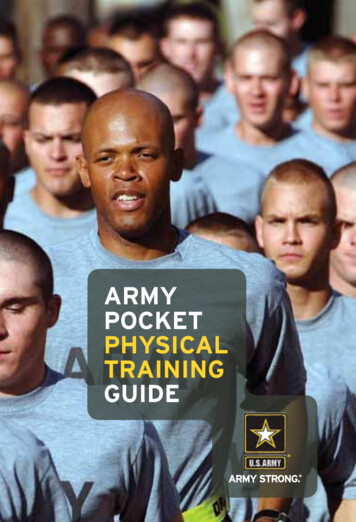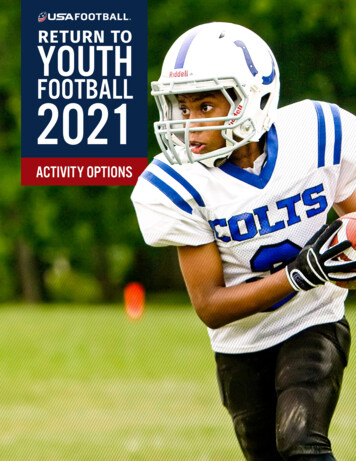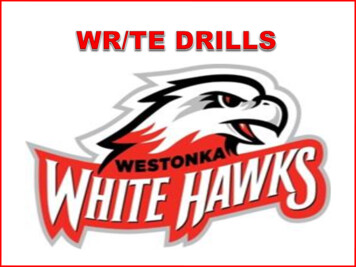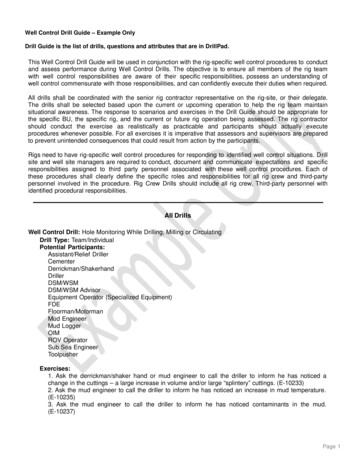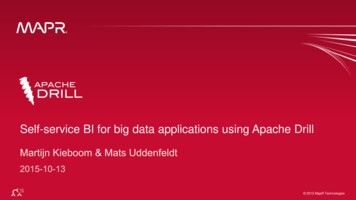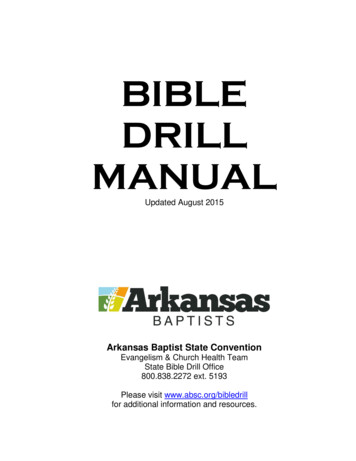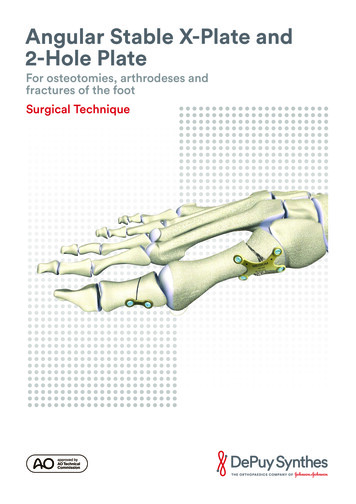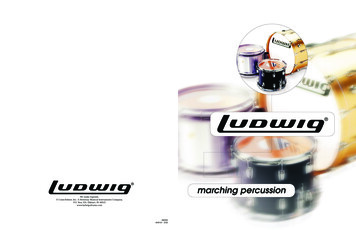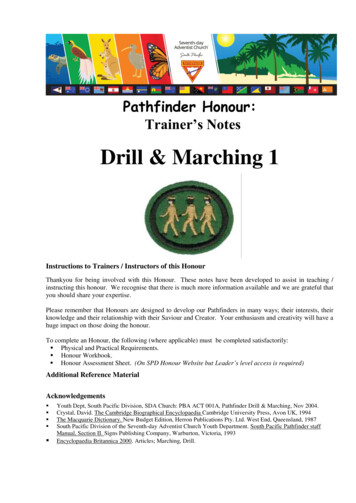
Transcription
Pathfinder Honour:Trainer’s NotesDrill & Marching 1Instructions to Trainers / Instructors of this HonourThankyou for being involved with this Honour. These notes have been developed to assist in teaching /instructing this honour. We recognise that there is much more information available and we are grateful thatyou should share your expertise.Please remember that Honours are designed to develop our Pathfinders in many ways; their interests, theirknowledge and their relationship with their Saviour and Creator. Your enthusiasm and creativity will have ahuge impact on those doing the honour.To complete an Honour, the following (where applicable) must be completed satisfactorily: Physical and Practical Requirements. Honour Workbook. Honour Assessment Sheet. (On SPD Honour Website but Leader’s level access is required)Additional Reference MaterialAcknowledgements Youth Dept, South Pacific Division, SDA Church: PBA ACT 001A, Pathfinder Drill & Marching, Nov 2004.Crystal, David. The Cambridge Biographical Encyclopaedia Cambridge University Press, Avon UK, 1994The Macquarie Dictionary. New Budget Edition, Herron Publications Pty. Ltd. West End, Queensland, 1987South Pacific Division of the Seventh-day Adventist Church Youth Department. South Pacific Pathfinder staffManual, Section II. Signs Publishing Company, Warburton, Victoria, 1993Encyclopaedia Britannica 2000. Articles; Marching, Drill.
Drill and Marching 1 HonourREQUIREMENT 1:Give the origin of drill and marching.There are many references in the Bible to marching. The original Hebrew wordrefers to walking as a group ready for battle, but not necessarily in step.It was not until the development of fighting methods by the Greeks, who discoveredthat a group of men compacted close together with their shields and weapons, wasa greater force than individual fighters. To achieve this successfully and to savethemselves falling over each other’s feet, they began to move in step and that laidthe basis of marching, as we know it today.Modern marching methods where first developed by Gustavus Adolphus II (1594– 1632) the King of Sweden. The other European nations and eventually most othernations around the world followed these methods.This expands upon the notion that marching relates only to a military term.Pathfinders use marching as a method of moving groups of Pathfinders in step asan organised body.REQUIREMENT 2:List five objectives of drill. Teaches a group how to work together Develops coordination in the physical development of the individual Sets the standard for the execution of any duty and builds a sense of confidencebetween the Club Staff and the Pathfinder which is essential to morale. Encourages self-confidence. This confidence includes the sense of having animportant place in a group of people It is an activity that is physical. The Pathfinder is physically involved in the activity. Introduces the Pathfinder to the concept of timing. That all of the marching, drillmovements can be executed together. Instils discipline and orderliness into the conduct of the Pathfinder that will carry oninto the church and community life when the Pathfinder grows to adulthood. Teaches the Club Staff how to use discipline to control activities involving thePathfinder. Engenders high morale and respect for authority when utilised correctly. It is fun.South Pacific Division of SDADocument Name: Drill and Marching 1 Honour Trainer s NotesCompiled: July 07, Paul Cresswell, S Qld Conf. Updated: 1 Mar 09, John Sommerfeld, S Qld ConfPage 2 of 10
Drill and Marching 1 HonourREQUIREMENT 3: Define the following terms:a. DrillStrict and often repetitious training using rigorous exercises.b. MarchingTo walk with regular and measured tread; advance in step in an organised body.c. FormationBody of personnel arranged in an orderly fashiond. AdvanceThe direction faced by the formation when the Right Marker is on the extremeright of the front rank.e. RetireThe direction faced when the formation is turned about from the Advance position.f. The Right (Left)That flank on the right (left) of the formation when it is advancing.Note: This designation does not change when the formation is retiring.g. Right (Left, Centre) MarkerThe designated person upon whom the rank align their dressing.h. RankA line of personnel standing side by side.i. FileA line of personnel standing one behind the other.j. IntervalThe lateral space between persons on the same alignment measured from flank toflank.k. CoverThe act of taking up a correct alignment, front to rear.l. DressingThe act of taking up a correct alignment, flank to flank.REQUIREMENT 4:Explain the following terms relative to words of command: DesignationThe person or group to whom the command is directed, for instance “Pathfinders”,and is always stated before the command is given. Cautionary stageThat part of the command where the word(s) or part thereof is drawn out to preparethe formation for action, eg. “about” Executive stageThat part of the command where the word or part thereof demands immediate action,eg, “TURN” The executive stage must be sharp, and of a higher pitch than thecautionary. Regulation pauseA pause equivalent to two beats of “Quick Time” (120 beats per minute) madebetween each and every stage in the execution of a command. “As you were”The command given when it is desired to stop an incomplete movement, cancel anincorrect order or return to the last position held.South Pacific Division of SDADocument Name: Drill and Marching 1 Honour Trainer s NotesCompiled: July 07, Paul Cresswell, S Qld Conf. Updated: 1 Mar 09, John Sommerfeld, S Qld ConfPage 3 of 10
Drill and Marching 1 HonourREQUIREMENT 5:Explain the following terms, comparing and contrasting the action of eachcommand at the Halt:aAttention,The position of “attention” is one of readiness in expectation of a word of command.Exactness in this position is important.The following position is adopted sharply: Place the heels together and in line. Feet turned out to an angle of 30 degrees. Knees braced. Body erect with the weight evenly between the balls of the feet and the heels. Shoulders level, and squared to the front. Arms hanging straight from the shoulders, elbows close to the sides. Wrists straight. Hands closed (not clenched), back of the fingers lightly touching the thighs. Thumbs straight and to the front. Head up; eyes open, steady, and finding their own height. No part of the body strained.Common Faults A strained and exaggerated position causing breathing to be restricted. Unsteadiness caused by not being correctly balanced on both feet. Feet and body not square to the front, heels not closed and in line. Arms bent, elbows pulled back. Wrists crooked. Feet not correct angle of 30 degrees. Scraping the feet on the ground. Rising on the toes and clicking the heels. Hopping or leaving the ground with both feet at once.b.Stand at ease,The following position is adopted sharply: Keeping the right foot still and the leg braced back, bend the left knee, carrythe left foot sharply to the left so that the feet are 20-30 cm (8-12”) apart,depending on the size of the Pathfinder, heels still in line, and the feet at thesame relative angle as in “attention.” Transfer the weight of the body evenly over both feet. At the same time bring the arms behind the back, keeping them straight, andplace the back of the right hand in the palm of the left, thumbs crossed, fingersand hands straight and pointing toward the ground or floor. Note that when a book or any articles are being carried on parade the arms willbe held to the side as for “attention.” The book or other such items that can becarried in one hand will be carried by the left. If articles are only carried in theleft hand, the right arm must remain at the side as for the position of“attention.” When marching, objects are to be held in the left hand and the armkept still. The right arm is free to swing in the normal manner.South Pacific Division of SDADocument Name: Drill and Marching 1 Honour Trainer s NotesCompiled: July 07, Paul Cresswell, S Qld Conf. Updated: 1 Mar 09, John Sommerfeld, S Qld ConfPage 4 of 10
Drill and Marching 1 HonourCommon Faults Failure to carry foot off 20-30 cm and not square to left. Not maintaining the angle of the foot and heels not in line. Movement of right foot and consequent loss of dressing. Binding forward during movement. Flapping the arms. Arms not fully extended. Hands not clasped in correct position.Attention from Stand at Ease Bend the left knee and bring the left foot to the position of “attention;” and At the same time bring the arms and hands to the position of “attention.”Position of Stand at EaseThe “stand at ease” is an intermediate position between “attention” and “standeasy.” It allows no relaxation, and cannot be maintained for a longer time than the“attention” position without strain.c.Stand easy, The head, body and limbs are relaxed. Clothing and equipment may beadjusted. Pathfinders must not move feet or talk, or lower hips. The position of “stand easy” is given when it is desirable to permit Pathfindersto relax. This command is only given when the club is in the position of“stand at ease.”Common Faults Moving the feet, resulting in losing position. Slouching and talking.d.Right / left turn, Keeping both knees straight, turn through 90 degrees to the right, on the rightheel and the ball of the left foot, raising the left heel and the right toe in doingso, keeping the weight of the body on the right foot. On completion of themovement the right foot is flat on the ground, the left leg to the rear with theheel raised, and turned slightly inwards. Both knees braced back, and arms inthe position of “attention.” Bend the left knee and bring the left foot sharply to the right into the positionof “attention.”Common Faults The weight being put on the rear foot, allowing the heel of the forward foot tomove over the ground instead of pivoting. Scraping the ball of the right foot over the ground, instead of lifting the toes. Bending the knee of the pivot leg, and bending forward particularly during thesecond movement. Not making a square turn with the body and shoulders. Moving the arms. Taking the right foot back to the left foot to complete the second movement,thus upsetting the dressing.South Pacific Division of SDADocument Name: Drill and Marching 1 Honour Trainer s NotesCompiled: July 07, Paul Cresswell, S Qld Conf. Updated: 1 Mar 09, John Sommerfeld, S Qld ConfPage 5 of 10
Drill and Marching 1 Honoure. About turn, Keeping both the knees straight, turn through 180 degrees to the right, on theright heel and the ball of the left toot, raising the left heel and the right toe indoing so, keeping the weight of the body on the right foot. On completion ofthe movement the right foot is flat on the ground, the left leg to the rear withthe heel raised, and turned slightly inwards. Both knees braced back, and armsin the position of “attention.” Bend the left knee and bring the left foot sharply to the right into the positionof “attention.”Common Faults The weight being put on the rear foot, allowing the heel of the forward foot tomove over the ground instead of pivoting. Scraping the ball of the right foot over the ground, instead of lifting the toes. Bending the knee of the pivot leg, and bending forward particularly during thesecond movement. Not making a square turn with the body and shoulders. Moving the arms. Taking the right foot back to the left foot to complete the second movement,thus upsetting the dressing.f. Salute (to the front) The right arm is kept straight, and raised sideways, palm of the hand down,fingers extended and together, thumb close to the forefinger. In the instant thearm becomes horizontal, bend the elbow; with the upper arm steady bring thehand to the head, palm out, so that the tip of the forefinger is 13 mm over theright eye. In this position the upper arm is horizontal and at right angles to theright side, the forearm, wrist and fingers in one straight line. The right hand is cut to the side by forcing the elbow to the side andstraightening the arm; the fingers are curled, and the muscles of the forearmare flexed during the downward travel to the position of “attention.”Common Faults Leaning to the left, straining the muscles, leaning backwards, holding the chinup, or forcing the head forward. Moving the head toward the hand. Elbow forward, forearm, wrist and fingers not in a straight line. Hand too high or too far over toward the centre of the forehead. Hand tilted forward, fingers not together, thumb extended downwards. Sliding the hand up in front of the face. Dropping the hand before dropping the elbow. Moving the body and the left arm. Flipping the right hand to the rear before resuming the position of “attention.”g. DismissThe Pathfinder: Turns right, Salutes to the Right (Their front), Counts to four (in “quick time”), Marches off the parade area.South Pacific Division of SDADocument Name: Drill and Marching 1 Honour Trainer s NotesCompiled: July 07, Paul Cresswell, S Qld Conf. Updated: 1 Mar 09, John Sommerfeld, S Qld ConfPage 6 of 10
Drill and Marching 1 HonourREQUIREMENT 6:Demonstrate the ability to properly execute the following basic drill at the Halt:a. Attention,b. Stand at ease,c. Stand easy,d. Right (left) turn,e. About turn,f. Salute (to the front)g. DismissREQUIREMENT 7:Explain the following terms, comparing and contrasting the action of eachcommand on the March:a.Quick march The Pathfinders will step off with the left foot, swinging the right arm forwardand the left arm to the rear, and march straight to the front unless otherwisedirected.While marching: The heel must strike the ground first, the weight then coming forward over theball of the foot as the moving leg passes the stationary leg. Every pace,including the first, will be 60 cm. Each leg must be swung forward naturally in a straight line. The arms must be swung freely and straight from the front to rear, reaching theextremity of their swing each time the heel comes to the ground. By locking the thumb over the second joint of the forefinger the arms andwrists will be kept straight and swung from the shoulder, hands reaching atleast as high as the belt of the Pathfinder in front and as high as possible to therear. The hand will be closed, but not clenched, thumbs leading. The shoulders will be held square to the front.Common Faults Flipping the forearm or hands across the body, either to the front or the rear. Bending the left knee when stepping off, thus taking a pace of less than 60 cm. Taking a pace of more than 60 cm. Bending forward at the waist, particularly when stepping off, and dropping theshoulders. Not punching the arms to the rear. Swinging the arms with the back of the hands leadingb.Halt The command will be given on the left foot. The Pathfinders will take a further pace with the right foot, a check pace of 60cm with the left foot by striking the ground with the left heel; complete themovement by bringing the right foot sharply to the left foot and snapping thearms to the sides, thus adopting the position of “attention.”South Pacific Division of SDADocument Name: Drill and Marching 1 Honour Trainer s NotesCompiled: July 07, Paul Cresswell, S Qld Conf. Updated: 1 Mar 09, John Sommerfeld, S Qld ConfPage 7 of 10
Drill and Marching 1 HonourCommon Faults Leaping off the ground Exaggerated upward swing with the right hand; bending the right forearm atthe elbow. Little or no backward swing with the left hand. Scraping the left foot along the ground. Taking too short a pace with the left foot. Failing to adopt the position of “attention” on completion of the movement.c.About turn The word of command is given as the left foot reaches the ground. Take another pace with the right foot to check forward momentum. At thesame time cut the arms to the sides. Raise left foot, turn body through 90 degrees to the right and place the left footdown with the instep in front of the toe on the right foot. Raise the right foot, turn the body through the further 90 degrees and place theright foot down, toe pointing in the new direction. Raise the left foot and place alongside the right foot. Commence to swing the arms as the right foot leads off in the new direction. In “B” to “E” above the foot is raised 20 cm from the ground.Common Faults Allowing the arms to move away from the sides during the turn. Not stepping forward in the new direction the full distance. Bending forward when stepping off in the new direction. Trying to move the stationary foot, before the moving foot strikes the ground,giving the impression of a “skip.” Coordination between arms and legs tends to become lost. There is a marked tendency toward not raising the knee high enough, thusracing the movement.d.Right / left turn, The word of command is given on the right foot. Bring the left knee forward and upward; remain balanced on the right leg. Turn the left foot across the body, with the upper part of the leg horizontal,foot hanging at the natural angle, left knee in front of the right knee. In thisposition, the left foot should be directly above the ground in front of the righttoe. The body and arms are to remain in the position of “attention.” By a vigorous straightening of the left knee, drive the left foot to the ground,with the instep just ahead of the right toecap. The instant the left foot strikes the ground, move the right foot out in the newdirection and continue marching. The arms are snapped to the side at the commencement of the first movementof the turn, eg. when the left knee is being raised in the right turn. The arms commence to swing as the right foot is moved forward in the newdirection.The procedure for the Left Turn is the same as the above with the followingproviso; the right and left terminology apply to the opposite foot, eg. Thecommand is given on the left foot.South Pacific Division of SDADocument Name: Drill and Marching 1 Honour Trainer s NotesCompiled: July 07, Paul Cresswell, S Qld Conf. Updated: 1 Mar 09, John Sommerfeld, S Qld ConfPage 8 of 10
Drill and Marching 1 HonourCommon Faults Allowing the arms to move away from the sides during the turn. Not stepping forward in the new direction the full distance. Bending forward when stepping off in the new direction. Trying to move the stationary foot, before the moving foot strikes the ground,giving the impression of a “skip.” Coordination between arms and legs tends to become lost. There is a marked tendency toward not raising the knee high enough, thusracing the movement.e.Right / left wheel The word of command may be given on either foot. When marching in two or three columns the inner Pathfinder will wheel on thecircumference of a circle with a radius of 60 cm and will change directionthrough 90 degrees. The spread of the wheel is governed by the ability of theoutside Pathfinders to keep pace by stepping out. The Pathfinders on the inner flank will glance inward from the corner of theireye and in order to maintain the dressing will vary the pace accordingly. Files in rear will march straight to their front and will follow on the groundcovered by the leading files. If it is desired to wheel through more than a right angle, the command “RightWHEEL,” will be given a second time. If it is desired to wheel through less than a right angle (even after a second“Right WHEEL” has been ordered), the command “for-WARD” will be givenwhen the leading section is facing the required direction. They will then leadstraight on. The arms will continue to swing through the entire wheel.Common Faults When wheeling in twos and threes; failure of inner Pathfinders to adjust lengthof pace to allow the outer Pathfinders to maintain dressing. A marked tendency for covering files to swing outwards on approaching thewheeling point. Arms not swinging through the entire wheel.The procedure for the Left Wheel is the same as the above.South Pacific Division of SDADocument Name: Drill and Marching 1 Honour Trainer s NotesCompiled: July 07, Paul Cresswell, S Qld Conf. Updated: 1 Mar 09, John Sommerfeld, S Qld ConfPage 9 of 10
Drill and Marching 1 HonourREQUIREMENT 8: Demonstrate the ability to properly execute the following basic drill on theMarch: Quick march Halt About turn Right / left turn Right / left wheelREQUIREMENT 9: As a member of a colour guard, take part in the opening or closing parade at oneof the following events: Club meeting, Club camp-out, Church parade, Pathfinder day programme.REQUIREMENT 10: Demonstrate the ability, when marching with the unit to: Keep in step, Maintain position, Perform required manoeuvres.South Pacific Division of SDADocument Name: Drill and Marching 1 Honour Trainer s NotesCompiled: July 07, Paul Cresswell, S Qld Conf. Updated: 1 Mar 09, John Sommerfeld, S Qld ConfPage 10 of 10
Pathfinder Honour: Trainer's Notes Drill & Marching 1 Instructions to Trainers / Instructors of this Honour Thankyou for being involved with this Honour. These notes have been developed to assist in teaching / instructing this honour. We recognise that there is much more information available and we are grateful that you should share your .
